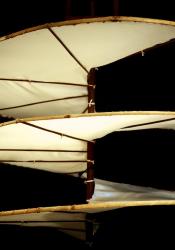Aerial Screw
Over two thousand years ago, tops consisting of a propeller affixed to a stick were created in China. By using one’s hands to spin the stick, the propeller could achieve lift and hover through the air for a short period of time. This basic concept is reflective in today’s modern helicopters. Leonardo da Vinci sketched designs for his own version of a flying machine, but unfortunately his concept has been determined by modern scientists to not work. This is in part due to him never actually building and testing his idea. However, the concept of using lift to carry a contraption through the sky was still revolutionary. The description "If this instrument made with a screw be well made – that is to say, made of linen of which the pores are stopped up with starch and be turned swiftly, the said screw will make its spiral in the air and it will rise high" was included next to the sketch of da Vinci’s helicopter. It was comprised mostly of a device meant to compress air in order to generate lift- the aerial screw or helical air screw. At full size, da Vinci imagined up a helicopter of over 15 feet in diameter, built out of reed, linen, and wire, which was to be powered by four men turning cranks to rotate a central shaft that turned the aerial screw. In 1796, Sir George Cayley was able to build his own version of a helicopter machine that was powered by elastic devices. Later on, in 1842, W. H. Philips developed a steam-driven model helicopter. All of these incredible designs followed the same principles of generating lift.
Sources:
“Helicopter (Aerial Screw).” Leonardo Da Vinci's Aerial Screw Invention, 2008, www.da-vinci-inventions.com/aerial-screw.aspx.
“Early Helicopter History.” Aerospaceweb.org, 2012, www.aerospaceweb.org/design/helicopter/history.shtml.
Image Source : Permission granted to share this work by Clay Shonkwiler under the Creative Commons Attribution 2.0 Generic license (https://commons.wikimedia.org/wiki/File:Leonardo_da_Vinci_Tank_Aerial_Sc...), "Leonardo da Vinci Tank Aerial Screw" https://creativecommons.org/licenses/by/2.0/legalcode.

